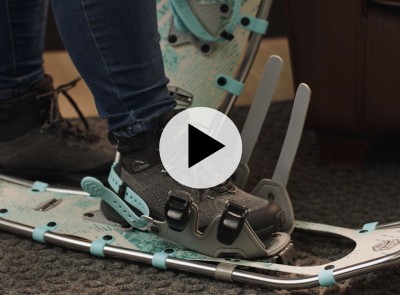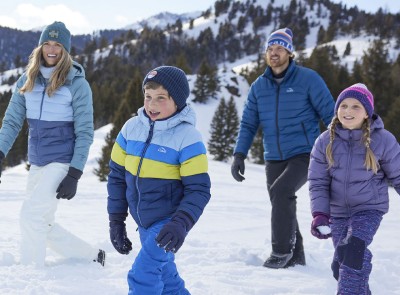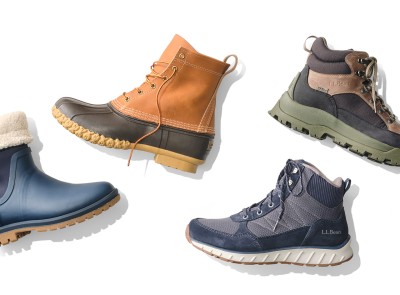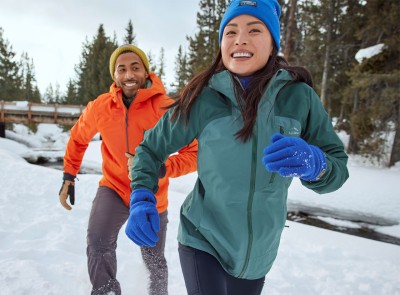(DESCRIPTION)
[00:00:00.00] A woman sits next to a glowing fireplace reading a book.
[00:00:01.89] Text, L L Bean, How to size snowshoes.
[00:00:06.15] She lowers the book and smiles. Mackenzie, Snow-it-all
(SPEECH)
[00:00:08.05] Hello there. My name is Mackenzie, and today we're going to look at how to properly size snowshoes. Snowshoe size is generally based on weight. And most snowshoes come with their own sizing guide. That's a great place to start, and it could be all you really need to do. But if you really want to fine tune your snowshoe fit, use these four tips to help you make the best choice.
(DESCRIPTION)
[00:00:27.88] A chalkboard rolls toward her. Text, 4 Tips for a Great Snowshoe Fit
(SPEECH)
[00:00:31.09] I take this thing with me everywhere. You know how in real estate they like to say location, location, location? Well, with sizing snowshoes, we're talking about flotation, flotation, flotation, flotation is the snowshoe's ability to keep you from sinking into the snow. The bigger the snowshoe, the more surface area it has which means more flotation. You want to snowshoe that has enough flotation, but bigger doesn't always mean better. If you go too big, you'll feel like you're walking through the snow in clown shoes.
(DESCRIPTION)
[00:01:01.19] The chalkboard shows a clown drawing.
(SPEECH)
[00:01:02.17] A snowshoe is generally sized based on your weight. However, it's important to keep in mind how much gear you'll be carrying when using them.
(DESCRIPTION)
[00:01:09.25] Text, 15 lbs versus 20 to 35 lbs
(SPEECH)
[00:01:09.76] If you're planning to go on a longer day hike or an overnight trip, you could be carrying a lot of extra gear, especially in winter. So if you're in between two sizes, you might want to think about sizing up. Another important variable is the snow conditions.
(DESCRIPTION)
[00:01:24.22] Packed snow versus fluffy snow.
(SPEECH)
[00:01:25.06] You need less flotation when hiking on packed trails versus walking through knee deep snow.
(DESCRIPTION)
[00:01:29.59] In a drawing on the chalkboard, a snowshoe sinks deeper in the fluffy snow.
(SPEECH)
[00:01:30.13] Sometimes where you live plays a big factor in this. Like in the US, out west, you may have drier, deeper snow and need to think about staying on top of it, so you'll want a bigger snowshoe with more flotation.
(DESCRIPTION)
[00:01:41.41] A drawing shows an outline of the United States.
(SPEECH)
[00:01:42.01] Here in the east, the snow tends to be wetter and tends to pack down more easily, so a bigger snowshoe might just get in the way.
[00:01:48.82] A good rule of thumb is to think about the conditions you'll wear them in the majority of the time. For a lot of us, that's probably closer to home for day hikes on packed trails. Unless you're planning for a big trip with a lot of gear, like I mentioned earlier, or you want to try something like snowshoe running-- it's a real thing-- you're probably best off following the standard sizing recommendations.
(DESCRIPTION)
[00:02:10.81] Text, Standard sizes are between 25 inches and 27 inches long.
(SPEECH)
[00:02:11.65] And that's it. Although there can be a lot to think about, finding the right size doesn't have to be complicated. With the right snowshoe, you can experience all the beauty winter has to offer.
(DESCRIPTION)
[00:02:21.24] She shoves the chalkboard and it rolls away.
(SPEECH)
[00:02:22.89] Happy trails.
(DESCRIPTION)
[00:02:23.88] Text, For more outdoor tips and inspiration, visit our Get Outside Guide at L L Bean dot com slash outside.
[00:02:32.58] Flames flicker in the fireplace.








